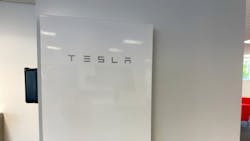25,000 PG&E, Tesla Customers Invited to Form Large Distributed Battery
Pacific Gas and Electric Company (PG&E) and Tesla Inc. have launched a new pilot program that creates a virtual power plant, to help support electric grid reliability and save customers money.
On June 22, Tesla invited approximately 25,000 PG&E customers with Powerwalls to join the VPP and help form the world’s largest distributed battery. In the first two weeks of the new program, more than 3000 customers have expressed interest in enrolling, with more than 1500 customers officially in the program.
Through this collaboration, Tesla is participating in PG&E’s Emergency Load Reduction Program (ELRP) pilot by enrolling and combining residential Powerwall home battery systems into a virtual power plant to discharge power back to the grid in California during times of high electricity demand. Participating customers will receive compensation for the energy their Powerwalls discharge.
“VPPs are a valuable resource for supporting grid reliability and an essential part of California’s clean energy future. Our customers’ home batteries offer a unique resource that can positively contribute to our state’s electric grid and will become more significant as our customers continue to adopt clean energy technology. In collaborating with Tesla, we are further integrating behind-the-meter battery-based VPPs on the largest scale yet, helping to make customer resiliency technologies more accessible and continuing a long tradition at PG&E of actively integrating VPP resources into our energy supply portfolio,” said PG&E’s Aaron August, vice president, Business Development & Customer Engagement.
This venture aims to accelerate the growing trend of customers adopting distributed energy resource technologies—which can both support customer energy needs and contribute to the reliability of the grid — by expanding access to new customer program offerings and participation opportunities.
“Enabling Powerwall customers to support the grid and their community is a necessary and important part of accelerating the transition to sustainable energy. We seek to partner with utilities and regulators everywhere to unlock the full potential of storage to bring more renewable, resilient, and less costly electricity to everyone,” said Tesla’s Drew Baglino, senior vice president of Powertrain and Energy Engineering.
How the PG&E Tesla VPP Works
PG&E will call load management events for participating customers, directing their battery to discharge when there is high demand for electricity from 4 to 9 p.m. (May through October).
Participating customers receive $2 for every incremental kilowatt-hour of electricity their Powerwall discharges during an event. Through their Tesla app, customers can set their backup power needs to ensure they still have enough energy for their personal, essential needs in the event of an outage, or they can opt-out of an event completely in the app, as necessary.
PG&E residential customers are eligible if they own a Tesla Powerwall, have an interconnection agreement with PG&E, and are not enrolled in other demand response programs.
Eligible customers can use their Tesla mobile app to sign up for the PG&E Tesla VPP or learn more here.
